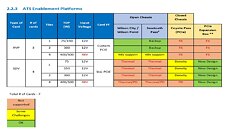Raevenlord
News Editor
- Joined
- Aug 12, 2016
- Messages
- 3,755 (1.24/day)
- Location
- Portugal
| System Name | The Ryzening |
|---|---|
| Processor | AMD Ryzen 9 5900X |
| Motherboard | MSI X570 MAG TOMAHAWK |
| Cooling | Lian Li Galahad 360mm AIO |
| Memory | 32 GB G.Skill Trident Z F4-3733 (4x 8 GB) |
| Video Card(s) | Gigabyte RTX 3070 Ti |
| Storage | Boot: Transcend MTE220S 2TB, Kintson A2000 1TB, Seagate Firewolf Pro 14 TB |
| Display(s) | Acer Nitro VG270UP (1440p 144 Hz IPS) |
| Case | Lian Li O11DX Dynamic White |
| Audio Device(s) | iFi Audio Zen DAC |
| Power Supply | Seasonic Focus+ 750 W |
| Mouse | Cooler Master Masterkeys Lite L |
| Keyboard | Cooler Master Masterkeys Lite L |
| Software | Windows 10 x64 |
A reportedly leaked Intel slide via DigitalTrends has given us a load of information on Intel's upcoming take on the high performance graphics accelerators market - whether in its server or consumer iterations. Intel's Xe has already been cause for much discussion in a market that has only really seen two real competitors for ages now - the coming of a third player with muscles and brawl such as Intel against the already-established players NVIDIA and AMD would surely spark competition in the segment - and competition is the lifeblood of advancement, as we've recently seen with AMD's Ryzen CPU line.
The leaked slide reveals that Intel will be looking to employ a Multi-Chip-Module (MCM) approach to its high performance "Arctic Sound" graphics architecture. The GPUs will be available in up to 4-tile configuration (the name Intel is giving each module), which will then be joined via Foveros 3D stacking (first employed in Intel Lakefield. This leaked slide shows Intel's approach starting with a 1-tile GPU (with only 96 of its 128 total EUs active) for the entry level market (at 75 W TDP) a-la DG1 SDV (Software Development Vehicle).


Then we move towards the midrange market through a 1-tile 128 EU unit (150 W), a 2-tile 256 EU unit (300 W) for the enthusiasts, and finally, a 4-tile, up to 512 EU — a 400-500 W beast reserved only for the Data Center. This last one is known to be reserved for the Data Center since the leaked slide (assuming it's legitimate) points to a 48 V input voltage, which isn't available on consumer solutions. Intel's design means that each EU has access to (at least by design) the equivalent of eight graphics processing cores per EU. That's a lot of addressable hardware, but we'll see if both the performance and power efficiency are there in the final products - we hope they are.
View at TechPowerUp Main Site
The leaked slide reveals that Intel will be looking to employ a Multi-Chip-Module (MCM) approach to its high performance "Arctic Sound" graphics architecture. The GPUs will be available in up to 4-tile configuration (the name Intel is giving each module), which will then be joined via Foveros 3D stacking (first employed in Intel Lakefield. This leaked slide shows Intel's approach starting with a 1-tile GPU (with only 96 of its 128 total EUs active) for the entry level market (at 75 W TDP) a-la DG1 SDV (Software Development Vehicle).


Then we move towards the midrange market through a 1-tile 128 EU unit (150 W), a 2-tile 256 EU unit (300 W) for the enthusiasts, and finally, a 4-tile, up to 512 EU — a 400-500 W beast reserved only for the Data Center. This last one is known to be reserved for the Data Center since the leaked slide (assuming it's legitimate) points to a 48 V input voltage, which isn't available on consumer solutions. Intel's design means that each EU has access to (at least by design) the equivalent of eight graphics processing cores per EU. That's a lot of addressable hardware, but we'll see if both the performance and power efficiency are there in the final products - we hope they are.
View at TechPowerUp Main Site






